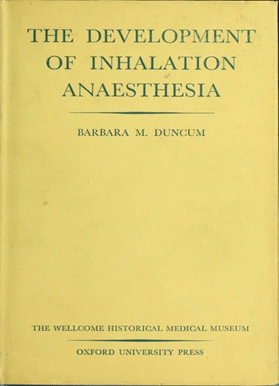The Early Historical Account of Inhalation Anaesthesia (1947), Barbara M. Duncum
By Joseph Toliver

The Development of Inhalation Anaesthesia with Special Reference to the Years 1846-1900 (1947) was quite a unique history book for the time. Barbara M. Duncum (1910-2001) studied history at the London University until she was elected to become an assistant researcher at the Wellcome Medical History Museum. She conducted historical research on cinchona and native Spanish medical procedures.
Duncum became quite versed in conducting research on the history of medicine and was appointed in 1936 to lead a journal-abstracting service, creating summaries for the documents and journals of the Museum. A year later in 1937, Barbara changed course and headed to Oxford to take a job for the Agricultural Research Institute. She was then asked to provide a brief history of anesthesia for Prof. Robert Macintosh, for a textbook he was writing, Essentials of General Anaesthesia [1]. Her work was so praised that she was offered a position as a historical researcher, and was encouraged to make this work the basis for a thesis for a doctorate in Philosophy [2].
Once she obtained her doctorate, she expanded on her thesis, and with the sponsorship of the Wellcome Museum, the book was published in 1947. It became the authoritative history of inhalation anesthesia and a classic for the history of medicine as a field of research. This work proved her place as a professional historian [3].
The Development of Inhalation Anaesthesia covered the major events that occurred in the history of anesthesia, including the beginning of pneumatics and the pioneers of inhalation anesthesia, the period when the use of ether and chloroform was established; the period of prevalent use of chloroform and the search for the best anesthetic; the revived use of nitrous oxide and ether; Paul Bert’s developments and introduction of premedication; and the beginning of modern anesthesia. The book covers the history of the field up to the early 20th century. No other history book at the time covered anesthesia so thoroughly. The section covering the discovery of chloroform and its early use in medicine, for example, not only covers the medical use of chloroform, but also details its discovery and the trial experiments conducted prior to making it the predominant chemical for anesthesia in the world [4].
The book encompasses the entirety of the history of chloroform right from the point of discovery with Simpson. With chloroform being one of the most influential anesthesias for the time, Duncum conducts a historical writing of all the advancements that came along with it. During the mid-19th century, anesthesia, let alone inhalation anesthesia, was quite new so the early experiences with chloroform provided insight into the process of what anesthesia needs to be. The introduction of chloroform was a precursor for all other anaesthesias. The section begins with a discussion of the advantages of chloroform over ether which was the most used anesthesia at the time. They assessed and altered the use of chloroform, changing the quantity and the speed at which chloroform is delivered. The early experiences with chloroform include figures depicting the various methods utilized for the delivery of chloroform as well as the scientist's accounts of their patients. The most important accounts were of those who experienced ether inhalation as well, as they could provide a perspective on how chloroform made them feel in comparison. As for the figures, they displayed the instrument along with the method of how the instrument was utilized.
The experiments with chloroform went into great detail. With each scientist’s experiment being performed, the entire process was included with the measurements of the reagents and the temperature at which it was administered. The early experiences display the gradual increase in new findings with chloroform and how scientists utilized this in order to perfect the process with their own ideas. The section begins with the birth of chloroform, progresses to its early life and people’s experiences with it, the rise of chloroform in the medical scene, and finally the fall of chloroform with the first fatality and the discovery of negative effects [5].
Duncum was able to create essentially the one and only historical account for anesthesia for the time. She retired in the late 1970s, but found herself back at work when she later become an honorary member of the History of Anaesthesia Society. She worked the rest of her days in London and continued to contribute new information and new findings. She passed away on October 16, 2001, at the age of 91.
(This post was written for the course HIST H364/H546 The History of Medicine and Public Health. Instructor: Elizabeth Nelson, School of Liberal Arts, Indiana University, Indianapolis).
References:
1. Neil Adams and David Zuck, “Obituaries: Barbara Duncum (1910-2001),” History of Anaesthesia Society, 2002, p. 103-105, https://assets-global.website-files.com/65003195ead7951cf39b2533/651be0a7c8c4fda10d1a8ffe_volume_30.pdf.
2. David Zuck, “Barbara Duncum (1910–2001),” Medical History 46, no. 2 (2002): 265–65. doi:10.1017/S0025727300069118.
3. Ibid.
4. Barbara M. Duncum, The Development of Inhalation Anaesthesia with Special Reference to the Years 1846-1900. London: Oxford University Press, 1947.
5. Duncum, The Development of Inhalation Anaesthesia with Special Reference to the Years 1846-1900. Ibid.,166-207
